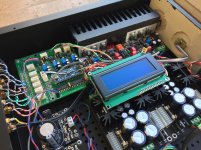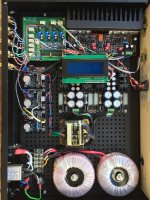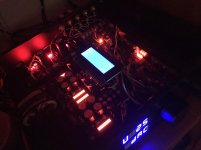Salas, I read something in the BOM(post 1) about shorting out various LEDs in order to get lower voltages from your DCSTB supply.
So I have a couple of questions:
1) What would I have to do to get +-12VDC from the supply? Would I short out 3 of the 10 LEDs of the Kingbright DCs per side or would it make more sense to skip the Kingbrights and just use seven 5mm red LEDs per side?
2) Would a 24V CT transformer supply enough voltage to get +-12VDC on the outputs?
Thanks!
1) Either solution will work. First one will look nicer, second one you can hand pick individual Leds for Vf if symmetry must be spot on in your application. In the first you can still vary the currents with R1 R2 to effect Vf total or add voltage with RxJ RyJ so to trim.
2) 5V Vin-Vout with such circuits is good to have across. Not that they won't work with less but for better performance. When using Schottky diodes you will be near there with 24VAC though. The mains stay usually higher than nominal also.
Marra;
Looks like you allready like this pre.
You will enjoy it more in time, belive me.
Jesper.
Jesper I think that you are right as I am very much enjoying what I am hearing so far; both through headset and speakers.
I did not have time to adjust/measure the offsets yet. Will try it today.Your pulse is healthy given your pace 😀
Offset was good? You need 0.17A bias?
I'm going to drive my Audeze LCD-2 (fazor) cans with DCG3 and the manufacturer recommends 1W(!) power for driving them, so at least at first I'll run with this bias. If the thing gets too hot with top cover, then maybe I'll try lower bias too. Maybe I could squeeze in a couple of quiet 60mm Noctua fans attached to the heat sink, if things get really hot and I need the power...
Naah don't let them scare you. Because they do 90dB SPL with only 0.18mW I see there: http://www.innerfidelity.com/images/AudezeLCD2sn5423021Fazer.pdf
That means 97.44 dB/mW on a 70 Ohm headphone. Little better than my DT770s 80 Ohm which claim 96dB/mw and proved much driveable on my 100mA bias unit. Yours will just have a higher SPL ceiling though because they will do less THD and their treble droop will let you also push them before sounding unbearable. I have listened to those cans, they are sweeter than neutral indeed.
That means 97.44 dB/mW on a 70 Ohm headphone. Little better than my DT770s 80 Ohm which claim 96dB/mw and proved much driveable on my 100mA bias unit. Yours will just have a higher SPL ceiling though because they will do less THD and their treble droop will let you also push them before sounding unbearable. I have listened to those cans, they are sweeter than neutral indeed.
* You could try 8.2R R10 for about 150mA with your D-Mosfet samples and take enough heat off without fear of missing drive I would guess.
Some numbers to play withNaah don't let them scare you. Because they do 90dB SPL with only 0.18mW I see there: http://www.innerfidelity.com/images/AudezeLCD2sn5423021Fazer.pdf
That means 97.44 dB/mW on a 70 Ohm headphone. Little better than my DT770s 80 Ohm which claim 96dB/mw and proved much driveable on my 100mA bias unit. Yours will just have a higher SPL ceiling though because they will do less THD and their treble droop will let you also push them before sounding unbearable. I have listened to those cans, they are sweeter than neutral indeed.
90dB from 0.18mW gives 97.4dB from 1mW
adding 20db to the 0.18mW allows AC maximums of 110dB from 18mW
18mW (110dB) into 70r requires outputs of 1.12Vac and 0.016Aac
180mW instantaneous peak transient (120dB peak) into 70r requires outputs of 3.55Vpk and 0.051Apk (=90mW)
Excruciatingly loud into 70r resistive requires only 51mApk
Allow 150%, i.e. 76mApk, for driving a reactive headphone with fast transients.
Notice how close the 3.55Vpk is getting to the commonly recommended 5V maximum for headphones.
Last edited:
Just finished my DCG3 DCSTB preamp, it has the arduino nano all-in-one LDR volume controller from the Group Buy section. Very happy with. It currently drives my Pass aleph J clone with more dynamics than the DCB1.
I used 130mA bias (10R) and gain 2. I will remove the arduino setup LCD after a while.
Thanks Salas and TeaBag for the offering.
Albert
I used 130mA bias (10R) and gain 2. I will remove the arduino setup LCD after a while.
Thanks Salas and TeaBag for the offering.
Albert
Attachments
A fully modern preamp system configuration. Congratulations. What attenuator impedance you calibrated for via the microcontroller? You will be probably discovering even more about sonic traits after familiar. Keep us posted.
Nice to see a "cousin" DCG3 build for my -still in progress- build! I'm also using the same LDR Controller in my project.
I measured the offsets, and it's hovering around 0,1...1,2mV in both channels. So no problems there.
I measured the offsets, and it's hovering around 0,1...1,2mV in both channels. So no problems there.
With the op-amp applied or before?Nice to see a "cousin" DCG3 build for my -still in progress- build! I'm also using the same LDR Controller in my project.
I measured the offsets, and it's hovering around 0,1...1,2mV in both channels. So no problems there.
My offset measurements were with the op-amp in place.
After the device running for about 45 min with the lid on the temps were 50 C on the DCG3 sink and 57 C on the PS sinks (the middle ones). I think I'm going to change the R10s to 10 ohm, since it seems to be giving around 130 mA bias with other users (Asanden). That should be plenty I think.
After the device running for about 45 min with the lid on the temps were 50 C on the DCG3 sink and 57 C on the PS sinks (the middle ones). I think I'm going to change the R10s to 10 ohm, since it seems to be giving around 130 mA bias with other users (Asanden). That should be plenty I think.
By the way. Do I need to re-adjust the DC offset after I change the R10 from 7,5 to 10 ohm?
Last edited:
Also after changing R6 for gain?By the way. Do I need to re-adjust the DC offset after I change the R10 from 7,5 to 10 ohm?
By the way. Do I need to re-adjust the DC offset after I change the R10 from 7,5 to 10 ohm?
The thermals should change so its good to have look again, but it could be close already
Also after changing R6 for gain?
I don't think so
By the way a circuitry detail is that I have kept R14 at a moderate value for the servo grip to be relatively light. Less intrusive. It gives 20x a servo output impedance vs the feedback resistor's to ground value (R7). If you got a small box or sink but also high bias that brings a lot of heat delta inside or your op-amp sample (when rolling types even) is a bit loose for tracking very well, lowering R14 value down to 5k will increase the grip. A 15k over R14 will bring it down to 7.5k for instance without de-soldering fuss. About subjective changes for that don't ask me as I never needed it.
Please excuse my ignorance. If I understand correctly, lowering R14 would increase the ability of the DCG3 to tolerate DC at the input?
You should not feed DC to any direct coupled preamp although the servo here can chase out some but its not its proper job. Its job is to keep the small natural shifts of the preamp in check.
Lowering R14 just makes it react more powerfully. Not recommended when there is no reason to think the offset wanders too highly or it corrects too slowly in some build.
Lowering R14 just makes it react more powerfully. Not recommended when there is no reason to think the offset wanders too highly or it corrects too slowly in some build.
- Home
- Source & Line
- Analog Line Level
- Salas DCG3 preamp (line & headphone)


